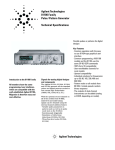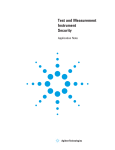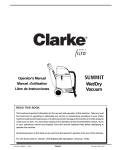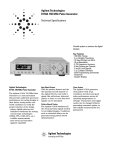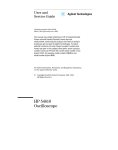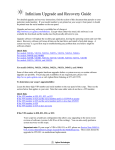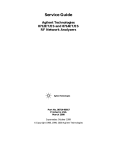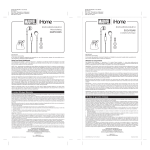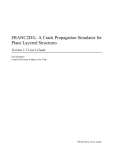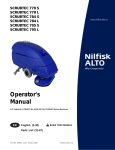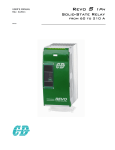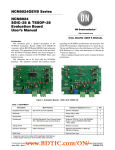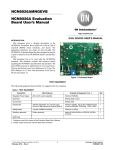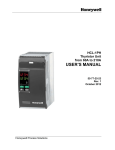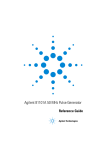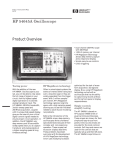Download Keysight Agilent HP 81131A Datasheet
Transcript
Test Equipment Solutions Datasheet Test Equipment Solutions Ltd specialise in the second user sale, rental and distribution of quality test & measurement (T&M) equipment. We stock all major equipment types such as spectrum analyzers, signal generators, oscilloscopes, power meters, logic analysers etc from all the major suppliers such as Agilent, Tektronix, Anritsu and Rohde & Schwarz. We are focused at the professional end of the marketplace, primarily working with customers for whom high performance, quality and service are key, whilst realising the cost savings that second user equipment offers. As such, we fully test & refurbish equipment in our in-house, traceable Lab. Items are supplied with manuals, accessories and typically a full no-quibble 2 year warranty. Our staff have extensive backgrounds in T&M, totalling over 150 years of combined experience, which enables us to deliver industry-leading service and support. We endeavour to be customer focused in every way right down to the detail, such as offering free delivery on sales, covering the cost of warranty returns BOTH ways (plus supplying a loan unit, if available) and supplying a free business tool with every order. As well as the headline benefit of cost saving, second user offers shorter lead times, higher reliability and multivendor solutions. Rental, of course, is ideal for shorter term needs and offers fast delivery, flexibility, try-before-you-buy, zero capital expenditure, lower risk and off balance sheet accounting. Both second user and rental improve the key business measure of Return On Capital Employed. We are based near Heathrow Airport in the UK from where we supply test equipment worldwide. Our facility incorporates Sales, Support, Admin, Logistics and our own in-house Lab. All products supplied by Test Equipment Solutions include: - No-quibble parts & labour warranty (we provide transport for UK mainland addresses). - Free loan equipment during warranty repair, if available. - Full electrical, mechanical and safety refurbishment in our in-house Lab. - Certificate of Conformance (calibration available on request). - Manuals and accessories required for normal operation. - Free insured delivery to your UK mainland address (sales). - Support from our team of seasoned Test & Measurement engineers. - ISO9001 quality assurance. Test equipment Solutions Ltd Unit 8 Elder Way Waterside Drive Langley Berkshire SL3 6EP T: +44 (0)1753 596000 F: +44 (0)1753 596001 Email: [email protected] Web: www.TestEquipmentHQ.com Agilent Technologies 81100 Family of Pulse Pattern Generators Technical Specifications Agilent 81110A Signals for testing digital designs and components Flexible pulses or patterns for digital designs The Agilent 81101A, 81104A, 81110A and 81130A generate all the standard pulses and digital patterns needed to test current logic technologies (CMOS, TTL, LVDS, ECL, etc.). Key Features With the optional second channel on all of the models from 80 MHz to 660 MHz, multi-level and multi-timing signals can be obtained using the internal channel addition feature. • Variable pulse parameters in pattern mode as well as in pulse mode (not on the 81130A) • Synchronously triggerable • Simulation of reflections/distortions (81104A, 81110A) • Three/four-level codes (81104A, 81110A) • Pattern mode on all models from 80 MHz to 660 MHz, including pseudo-random binary sequence. • The outputs of dual-channel instruments can be added (analog or EXOR, depending on model). • User-retrofittable channels for most models • Upward compatibility • Individual solutions for frequencies up to 50, 80, 165, 330, 400 and 660 MHz •100% form/fit compatibility Stimulate the device's environment Glitch-free timing changes Timing values can now be swept without the danger of misleading pulses or dropouts that could cause measurement errors. (Applies to continuous mode, values < 100 ms, consecutive values between 0.5 and twice the previous value on the 81101A, 81104A, 81110A) which has differential outputs and two selectable transition times. The Agilent 81130A offers a choice of output modules: the Agilent 81131A 400 MHz, 3.8 V module and the Agilent 81132A 660 MHz, 2.5 V module which has complementary outputs. Reliable measurements Easy-to-use All models provide clean, accurate pulses with excellent repeatability, thus contributing to measurement integrity. Features such as the clear graphical display, autoset, help, store/recall, preset TTL/ECL levels, selectable units (such as current/voltage, width/duty-cycle), and load compensation ensure a high level of convenience. The Agilent 81110A features selfcalibration for more accuracy. It also offers a choice of output modules. The Agilent 81111A 165 MHz 10 V module with variable transitions. Along with the Agilent 81112A 330 MHz 3.8 V module, Today's devices can require very complex stimuli. To meet this, the Agilent 81130A can sequence and loop its memory for very deep patterns. RZ (return-to-zero), NRZ (non-return-to- zero) and R1 (return-to-one) formats are available. Digital channel addition allows the generation of signals with two different pulse widths and delays or of data rates up to 1.32 Gbit/s in one single channel. Frequency range The Agilent 81130A is designed and recommended for an operation in the frequency range of 170 kHz to 400/660 MHz. However it can be operated in the extended range down to 1 kHz. Agilent 81100 - Family of Pulse Pattern Generators Mainframes Channel Model Nr. of channels Frequency range Period range Variable delay range Period RMS jitter Width range Amplitude range 81101A n.a. 1 Single ended 1 mHz 50 MHz 20 ns to 999.5 s 0.00 s 999.5 s 0.01% + 15 ps2 10 ns to 999.5 s 81104A 81110A3 81130A 81105A 81111A 81112A 81131A 81132A 1 or 2 1 or 2 1 or 2 Single Single ended differential Single ended differential ended 1 mHz 1 mHz 1 mHz 1 kHz 1 kHz 80 MHz 165 MHz 330 MHz 400 MHz 660 MHz 12.5 ns to 6.06 ns to 1.515 ns 2.5 ns to 1 . 5 n s to 999.5 s 999.5 s to 999.5 1 ms 1 ms 0.00 ns 0.00 ns - 999.5 s 0.00 ns to 3.00 µs 999.5 s 0.01% + 15 ps2 0.01% + 0.01% + 15 ps2 15 ps2 6.25 ns to 3.03 ns to 1.515 ns to 1.25 ns to 70 ps to 999.5 s 999.5 s 999.5 s (period-1.25 (period-750 ns) ps) 100 mV to 100 mV to 100 mV to 100 mV to 100 mV to 100 mV to 20.0 V1 20.0 V1 3.8 V 3.8 V 2.5 V 20.0 V1 5.00 ns to 3.00 ns to 2.00 ns to 800 ps or 1.6 800 ps or 1.6 500 ps typ. 200 ms 200 ms 200 ms ns selectable ns selectable fixed yes yes yes No Transition time range (10/90) Dropout- and glitch- free timing change Source Impedance 50 Ω or 1 kΩ (1) (2) (3) Page 2 50 Ω or 1 kΩ 50 Ω or 11 kΩ 50 Ω 50 Ω Depends on selected impedance ( all other values for 50 Ω source impedance into 50 Ω load) 0.001% +15 ps with internal PLL as clock source Also avalable as VXI Pulse Pattern Gernerators E8311A and E8312A Data Sheet 81100 Family of Pulse Pattern Generators 81101A Specifications Timing Characteristics Measured at 50% amplitude at fastest transitions in continuous mode and 50 Ω source impedance. Mainframe Frequency range Timing resolution Period RMS jitter With PLL With VCO Period range Accuracy with PLL /VCO Agilent 81101A 1mHz to 50MHz 3.5 digits, 5ps best case 0.001% + 15 ps 0.01% + 15 ps 20ns to 999.5 s \ 0.01% (\5%) (similar to RMS Jitter) 10.0 ns to (period - 10.0 ns) \5% \250 ps (1) 0.01% + 15 ps 0 ns to (period -20 ns) \5% \1 ns 0.01% + 15 ps (width + 10.0 ns) to (period- width - 10.0 ns) \5% \ 500 ps 5 ns to 200 ms variable \10% \200 ps 3% typ. for transitions > 100 ns Width range Accuracy RMS Jitter Additional variable delay range Accuracy (2) RMS Jitter Double pulse delay range Accuracy Transition time range (10/90) Accuracy Linearity Note: (1) Changing of amplitude may add 0.5 ns. (2) Width accuracy specification is valid up to 5.5 Vpp amplitude. Above this amplitude, the width will typically increase up to 300ps Burst Count: 2 to 65536 (single or double pulses). Delay: Delay, phase or % of period. Double pulse delay: Double pulse and delay are mutually exclusive. Duty cycle: Set between 0.1% and 95% (subject to width limits. 99.9% with overprogramming). Transition times: These can be Entered as leading/ trailing edge or % of width. Leading and trailing edges are independent within one of the following overlapping segments (1:20 ratio): 5 ns - 20 ns, 10 ns - 200 ns, 100 ns - 2 µs, 1µs - 20 µs, 10 µs - 200 µs, 100 µs - 2 ms, 1 ms - 20 ms, 10 ms 200 ms. Transition times: These can be entered as leading/ trailing edge or % of width. Leading and trailing edges are independent within one of the following overlapping segments (1:20 ratio): 5 ns - 20 ns, 10 ns - 200 ns, 100 ns - 2 µs, 1µs - 20 µs, 10 µs - 200 µs, 100 µs - 2 ms, 1 ms - 20 ms, 10 ms - 200 ms. Repeatability: Is typically four times better than accuracy Output timing fidelity: Period, delay and width are continuously variable without any output glitches or dropouts. Data Sheet 81100 Family of Pulse Pattern Generators Page 3 Level/Pulse Performance Characteristics Level specifications are valid after a 30 ns typical settling time. Agilent 81101A 100 mVpp to 10.0 Vpp 200 mVpp to 20.0 Vpp -10.0 V to +10.0 V -20.0 V to +20.0 V \ (3% + 75 mV) \ (3% + 150 mV) 1) 10 mV 20 mV BNC single-ended Selectable 50 Ω or 1 kΩ Typ. \ 1% \ 24 V \ 400 mA max. 10 mV RMS typ. \ 5% of amplitude \ 20 mV 50 Ω into 50 Ω 1 kΩ into 50 Ω Level window 50 Ω into 50 Ω 1 kΩ into 50 Ω Accuracy 50 Ω into 50 Ω 1 kΩ into 50 Ω Resolution 50 Ω into 50 Ω 1 kΩ into 50 Ω Output connectors Source Impedance Accuracy Max. external voltage Short circuit current Base line noise Overshoot/preshoot/ringing Amplitude Note: (1) In ±19 V level window Trigger Modes Manual: Simulates an external input signal. Continuous: Continuous pulses, double pulses or bursts (single or double pulses). Internal triggered: Internal PLL replaces an external trigger source. External triggered: Each active input transition (rising, falling or both) generates a single or double pulse or burst. External gated: The active input level (high or low) enables pulses, double pulses or bursts. The last single / double pulse or burst is always completed. Ext. input: Used for trigger, gate or external width. Level parameters: Can be entered as voltage or current, as high and low level, or as offset and amplitude. Load compensation: The actual load value can be entered (for loads ≠50 Ω) to display actual output values. On/off: Relays connect/disconnect output (HiZ). Normal/complement: Selectable. Limit: Programmable high and low levels can be limited to protect the device-under- test. Input impedance: 50 Ω/10 kΩ selectable. Threshold: -10 V to +10 V. Inputs and Outputs Max. input voltage: ±15 Vpp. Clock input/PLL reference and Sensitivity: 300 mVpp typical. external input: One input (BNC connector at rear panel) is used for clock input or alternatively for the PLL. Input transitions: <100 ns. Frequency: Dc to 50 MHz . Minimum pulsewidth: 10 ns External width: The pulse shape can be recovered whilst the period and width of an external input signal are maintained. Levels and transitions can be set. PLL Reference: The internal PLL is locked to an external 5 MHz or 10 MHz reference frequency. Clock input: The output period is determined by the signal at CLK input. Strobe output and trigger output Trigger format: One pulse per period with 50% duty cycle typical. External mode: 9 ns typ. Typical delay times Agilent 81101A Level: TTL or ECL selectable. Instrument mode External width From Ext. Input All other modes Ext. Input/Clk input Strobe/Trigger out Page 4 To Strobe/Trigger out Output 1/Output 2 Strobe/Trigger out Output 1/Output 2 Output 1/Output 2 Typ. value 8.5 ns 22.5 ns 12.0 ns 29 ns 17 ns Output impedance: 50 Ω typical. Max. external voltage: -2 V/+7 V. Transition times: 1.0 ns typical for TTL, 600 ps typical for ECL. Data Sheet 81100 Family of Pulse Pattern Generators 81104A and 81110A Specifications Timing Characteristics Measured at 50% amplitude at fastest transitions in continuous mode and 50 Ω source impedance. Mainframe Output module Frequency range Ω From 1 KΩ Timing Resolution Period Range Period RMS jitter With PLL With VCO Accuracy with PLL VCO Width range Agilent 81104A Agilent 81105A 1 mHz to 80 MHz Up to 50 MHz typ. 3.5 digits, 5 ps best case 12.5 ns to 999.5 s Min period Accuracy ± 5% ± 250 ps Transition time range (10/90) Minimum (with overprogramming) Accuracy Linearity Agilent 81110A Agilent 81112A 1 mHz to 330 MHz N/A 0.001% + 15 ps 0.01% + 15 ps 0.001% +15 ps ± 0.01% (± 5%) 6.25 ns to (period 6.25 ns) ± 5% ± 250 ps 0.01% + 15 ps 0 ns to (period -12.5) ± 5% ± 0.5 ns 0.01% +15 ps 12.5 ns to (period - width - 6.25 ns) 25 ns (40 MHz) typ. Accuracy Jitter (RMS) Add. Variable delay range Accuracy Jitter (RMS) Double pulse delay range Agilent 81110A Agilent 81111A 1 mHz to 165 MHz Up to 60 Mhz typ. 3 ns to 200 ms ± 0.01% (± 0.5% typ. After self-cal., ± 3% without self-cal.) 3.03 ns to 1.515 ns to (period - 3.03 ns) (period - 1.515 ns) ± 0.5% ± 250 ps typ. After self-cal. ±3% ± 250 ps 0 ns to (period -3.03 ns ) ± 0.5% ± 0.5 ns typ. ± 3% ± 0.5 ns after self-cal. 6.06 ns to (period width - 3.03 ns) 12.2 ns (82 MHz) typ. 3.03 ns to (period - width - 1.5) 6.06 ns (165 MHz) typ. ±0.5% ± 150 ps typ. ± 3% ± 150 ps after self-cal. ±0.5% ± 150 ps typ. ± 3% ± 150 ps after self-cal. 2 ns to 200 ms variable variable ≤ 3 ns ≤ 2ns/1.4 ns typ. For ELC levels (20/80) 5 ns typ. For 1 KΩ source impeded ± 10% ± 200 ps typ. ; ± 10% ± 400 ps 3% typ. For transitions > 100 ns Burst Count: 2 to 65536 (single or double pulses). Repeatability: is typ. four times better than accuracy. Delay: delay, phase or % of period. Transition times: leading/ trailing edge or % of width. Leading and trailing edges are independent Agilent 81111A/Agilent 81105A) within one of the following overlapping segments (1:20 ratio): 2 ns (3 ns) - 20 ns, 10 ns - 200 ns, 100 ns - 2 ms, 1µs - 20 µs, 10 µs - 200 µs, 100 µs - 2 ms, 1 ms - 20 ms, 10 ms - 200 ms. Double pulse and delay: mutually exclusive. Duty cycle: set between 0.1% and 95% (subject to width limits. 99.9% with overprogramming). 0.8 ns or 1.6 ns selectable ≤ 600 ps for Vpp ≤ 1 V 450 ps typ. For ELC levels (20/80) ≤ 900 ps for Vpp > 1 V N/A Output timing fidelity: period, delay and width are continuously variable without any output glitches or dropouts. Overprogramming: all parameters of the Agilent 81110A, except transitions, can be set to whatever the 330 MHz timing system will allow. This applies also when the Agilent 81111A (165 MHz) output module is used. Data Sheet 81100 Family of Pulse Pattern Generators Page 5 Level/Pulse Performance Characteristics Level specifications are valid after a 5 ns (Agilent 81112A) or 30 ns (Agilent 81111A/Agilent 81105A) typical settling time. Mainframe Amplitude Level window Accuracy Resolution 50 Ω into 50 Ω 50 Ω into 50 Ω Ω into 50 Ω 1 kΩ 50 Ω into 50 Ω Ω into 50 Ω 1 kΩ 50 Ω into 50 Ω Ω into 50 Ω 1 kΩ Output connectors Source Impedance Accuracy Max. external voltage Short circuit current Dynamic Crosstalk Base line noise Overshoot/preshoot/ringing Agilent 81101A Agilent 81110A Agilent 81105A Agilent 81111A 100 mVpp to 10.0 Vpp -10.0 V to +10.0 V -20.0 V to +20.0 V ± (3% + 75 mV) ± (1% + 50 mV) ± (1% + 100 mV)(1) ± (3% + 150 mV) [1] 10 mV 20 mV BNC single-ended Selectable 50 Ω or 1 kΩ Typ. ± 1% ± 24 V ±400 mA max. (doubles for channel addition) < 0.1% typ. 10 mV RMS typ. 4 mV RMS typ. ± 5% of amplitude ± 20 mV Agilent 81110A Agilent 81112A 100 mVpp to 3.8 Vpp - 2.0 V to 3.8 V N/A ± (2% + 50 mV) N/A 10 mV N/A BNC differential 50 Ω only -2.2 V to +5.5 V -84 mA to + 152 mA ± 5% of amplitude ± 50 mV Note: (1) in ± 19 V level window Level parameters: voltage or current, high or low level, offset or amplitude. On/off: relays connect/ disconnect output (HiZ) Load compensation: the actual load value can be entered (for loads ≠ 50 Ω) to display actual output values. (Applies to the Agilent 81105A and Agilent 81111A only). Normal/complement: selectable. Limit: programmable high and low levels can be limited to protect the device-under- test. Channel Addition (with Agilent 81105A or Agilent 81111A output channels) If the instrument is equipped with 2 output modules, channel 2 can be added to channel 1 internally. In this case the second output is disabled. The additional fixed delay on the second channel is typ. 2.5 ns. The following parameters differ from the above specifications if two output modules (Agilent 81105A/Agilent 81111A) are added. Mainframe Amplitude 50 Ω into 50 Ω 1 kΩ into 50 Ω Source Impedance Level window 50 Ω 1 kΩ Max. frequency 50 Ω 1 kΩ Min. transitions 50 Ω 1 kΩ Page 6 into 50 Ω into 50 Ω channel channel channel channel Agilent 81104A with two Agilent 81110A with two Agilent 81105A output modules Agilent 81111A output modules 100 mVpp tp 20.0 Vpp 200 mVpp to 20.0 Vpp Selectable from 50 Ω or 1 kΩ -20.0 V +20.0 V -20.0 V to +20.0 V 60 MHz typ. 15 MHz typ. 2 ns typ. (channel one) 5 ns typ. (channel two) 20 ns typ. both channels Data Sheet 81100 Family of Pulse Pattern Generators Pattern Mode Pattern length: 16 kbit/channel and strobe output. Manual: simulates an external input signal. Output format: RZ (return to zero), NRZ (non-return to zero), DNRZ (delayed nonreturn to zero). Internal triggered: internal PLL replaces an external trigger source. Pulses, double pulses, bursts or patterns can be set. Random pattern: PRBS 2^(n-1) n = 7,8,...,14. Inputs and Outputs Transitions: < 100 ns. Frequency: dc to max. frequency of output module. Min. pulsewidth: 1.5 ns (as width of output module in external width mode). Strobe output and trigger output Clock input/PLL reference and external input Trigger Modes Continuous: continuous pulses, double pulses, bursts (single or double pulses) or patterns. External triggered: each active input transition (rising, falling or both) generates a single or double pulse, burst or pattern. External gated: the active input level (high or low) enables pulses, double pulses, bursts or patterns. The last single/double pulse, burst or pattern is always completed. External width: the pulse shape can be recovered. Period and width of an external input signal is maintained. Delay, levels and transitions can be set. PLL reference: (BNC connector at rear panel). The internal PLL is locked to an external 5 MHz or 10 MHz reference frequency. Clock input: (BNC connector at rear panel). The output period is determined by the signal at CLK input. Ext. input: used for trigger, gate or external width. Input impedance: 50 Ω/10 kΩ selectable. Strobe output: user-defined, 16 kbit pattern (NRZ) when in pattern mode. Trigger format: one pulse per period with 50% duty cycle typical. External mode: 1.5 ns typ. for Agilent 81110A. 5.9 ns typ. for Agilent 81104A. Level: TTL or ECL selectable. Output impedance: 50 Ω typical. Max. external voltage: - 2 V/+7 V. Transition times: 1.0 ns typical for TTL, 600 ps typical for ECL. Threshold: - 1 0 V to + 10 V. Max. input voltage: ± 15 Vpp. Sensitivity: ≤ 300 mVpp typical. Typical delay (Agilent 81110A with Agilent 81111A output module) [1] Instrument mode External width From Ext. Input All other modes Ext. Input/Clk Input Strobe/Trigger out To Typ. value Strobe/Trigger out Output 1/Output 2 Strobe/Trigger out Output 1/Output 2 Output 1/Output 2 8.5 ns 19.5 ns 12.0 ns 26.0 ns 14.0 ns Note: [1] Subtract 4 ns from the typ. delay value when referring to OUTPUT1/2 for the Agilent 81112A output module and add 1 ns when referring to OUTPUT1/2 for the Agilent 81104A with the Agilent 81105A output module. Data Sheet 81100 Family of Pulse Pattern Generators 81130A Specifications Timing Characteristics Measured at 50% amplitude at fastest transitions in continuous mode and 50 Ω source impedance. The Agilent 81130A is designed and recommended for an operation in the frequency range of 170 kHz to 400/660 MHz. However it can be operated in the extended range down to 1 kHz. Changes in specifications below 170 kHz are marked. Mainframe Output module Agilent 81130A Agilent 81131A Frequency range Frequency resolution Period Range Accuracy RMS jitter (int ref, int clk) Width range Width resolution Width accuracy Width jitter Add, variable delay range Delay resolution Delay accuracy Delay jitter Fixed delay (clk in to out) (ext. in to out) Transition time range (10/90) Minimum transition (10/90) At ELC levels (20/80) Deskew range 170 kHz (1 kHz) to 400 MHz 4 digits, (2 ps best case) 2.5 ns to 5.9 µs 1.50 ns to 5.9 µs (f < 170 kHz: 2.5 ns to 1 ms) ± 100 ppm 0.001% + 15 ps 1.25 ns to period - 1.25 ns) 4 digits ( 2 ps best case) (f < 170 kHz: 0.05% of period) Agilent 81130A Agilent 81132A 170 kHz (1 kHz) to 660 MHz (f < 170 kHz: 1.5 ns to 1.0 ms) 1.25 ns to period - 1.25 ns) ± (100 ppm + 200 ps) (f < 170 kHz: 0.06% of period) 0.001% + 15 ps 0 to 3.00 µs independent of period ( > 3 µs: one to 1 period) 4 digits (2 ps best case ) (f < 170 kHz: ± 0.05% of period) ± (0.01% + 100 ps) relative to zero delay (f < 170 kHz: ± 0.035% of period) 0.001% + 15 ps 53 ns 54 ns + 0 to 1 period (1) 800 ps or 1600 ps fixed ≤ 600 ps for Vpp ≤ 1 V ≤ 900 ps for Vpp ≤ 1 V 500 ps typ. 450 ps typ. < 350 ps (200 ps typ.) ± 25 ns Note: (1) The uncertainty of 1 period can be eliminated if an external clock and the following setup and hold times are upheld. setup time: 0.3 ns to 4.3 ns; hold time: -2.8 ns to 4.0 ns. Burst Count: 2 to 65504. Delay: delay, phase or % of period. Duty cycle: set between 0.1% and 99,9% (subject to width limits). Repeatability: is typ. four times better than accuracy. Page 8 Data Sheet 81100 Family of Pulse Pattern Generators Level/Pulse Performance Characteristics Level specifications are valid after a 30 ns typical settling time (50 Ω into 50 Ω terminated to ground). Mainframe 81130A Output module 81131A (400 MHz) Amplitude 0.10 Vpp to 3.80 Vpp Level Window -2.00 V to +3.80 V Accuracy ± (5% +150 mV) Resolution 3 digits (10 mV best case) Output Impedance 50 Ω ± 1%typ. Max. external voltage - 2.2 to +5.5V Short circuit current -80 mA to +152 mA. Baseline noise 4 mV RMS typ. Overshoot/preshoot/ringing ±(5% + 50 mV) of amplitude typ. Level parameters: Voltage or current, high and low level, or offset and amplitude. Pattern and Sequencing Pattern length: 65504 bit/channel. If PRBS is used: (65503RBLength) Pattern formats: NRZ (nonreturn-to-zero), DNRZ (delayed non-return-to-zero), RZ (return-to-zero) and R1 (return-to-one) can be selected (see figure 1) 81130A 81132 A (660 MHz) 0.10 Vpp to 2.50 Vpp -2 .00 V to +3.00 V 50 Ω ±5%typ. -2.0 to +4.0 V -80 mA to +120 mA 8 mV RMS typ. ±(5% + 100 mV) of amplitude typ. Sequencing: A sequence is a succession of segments. One outer loop running once or continuous, and one nested loop can be applied. The nested loop can be set from 1 to 2^20 repetitions. Segment: The memory can be divided into maximal 4 segments. Segment length resolution: This is the resolution for which the segment can be set dependent on the maximum data rate. (see table 1) Limit: Programmable high and low levels can be limited to protect the device-under- test. Segment types: Pattern, PRBS, high and low segments ( "0" or "1" levels segments selectable). Note: If one channel is set to PRBS the other channel can only be high or low segments, or PRBS type. Random Pattern: PRBS 2^n-1, n = 7,8,...,15 (CCITT 0.151) On/off: Relays connect/disconnect output (HiZ). Required Segment length resolution [1] 1 bit 2 bits 4 bits 8 bits 16 bits Maximum data rate, Mbit/s 41.67 83.88 166.67 333.33 660 Table 1 . Segment length resolution trade-offs Figure 1: Pattern Formats [1] The minimum length in the first segment of a nested loop is two times that of the segment length resolution. Data Sheet 81100 Family of Pulse Pattern Generators Page 9 Digital Channel Addition Channel 1 can be logically combined with channel 2 (XOR) as shown in Figure 2. The source impedance remains 50 Ω. Output 2 is still available in this case. External gated: The active input level (high or low) enables pulses, bursts or patterns. On an external gate signal the output is immediately stopped, that means the last cycle will not be completed. External clock: The output period is determined by the signal at clock input. Manual: Simulates an external input signal with push of a front panel button. Delay from input trigger output: 21ns. Inputs and Outputs Clock input/PLL reference and external input Clock Input frequency: 170 kHz to 660 MHz (at 50% ±10% duty cycle) Delay from input to output: 53ns Threshold: ac coupled Only valid for external input Figure 2: Channel addition Trigger Modes Continuous: Continuous pulses, bursts or patterns. External started: Each active input transition (rising, falling edge) generates pulses, bursts or patterns. Connectors: SMA (f) 3.5 mm Input impedance: 50 Ω Termination voltage: -2.10 V to 3.30 V Input sensitivity: < 400 mV typ. Max. Input Voltage: - 3 V to + 6 V Input transitions: < 20 ns Only valid for clock input/PLL reference One input is used for clock input or for the PLL reference alternatively. External input: Used for external started or gated Input frequency: DC to 330MHz Delay from external input to trigger output: 22ns + 0 to 1 period Delay from external input to output: 54 ns + 0 to 1 period Threshold: -1.4 V to +3.7 V Reference: The internal PLL is locked to the 1,2,5 or 10 MHz. Trigger format: One pulse per period with 50% duty cycle typical. In pattern mode the trigger pulse can be set to mark the start of any segment. Programming times: (measured at display off.) ASCII Command Width, delay,transition times Period within one range [1] Period between different ranges [1]: In pulse/burst mode in pattern mode Levels Trigger modes Input parameters Save setting Recall setting: a) in pulse/burst mode b) in pattern mode with data and PRBS (depends on setting) 65504 bit pattern transfer Pattern and sequencing (depends on setting) Trigger output Typical execution time 40 ms to 70 ms 100 ms to 260 ms 140 ms to 300 ms 100 ms to 5.05 s 43 ms < 75 ms 28 ms 200 ms Output impedance: 50 Ω typical. Level: TTL/ETTL (for frequency < 180 MHz), 1 V to GND, ECL 50 Ω to GND/-2 V, PECL 50 Ω to + 3 V. Max. external voltage: -2 V/+3 V. 515 ms to 800 ms 1.15 s to 5.5 s Transition times: 1.0 ns typical for TTL, 600 ps typical for ECL. 1.25 s 190 ms to 5.1 s Delay from external input to trigger output: 32 ns typical [1] Range depends on segment length resolution, see table 1 Page 10 Data Sheet 81100 Family of Pulse Pattern Generators Common Specifications General Inputs and Outputs User Interface Operating temperature: 0°C to +55°C. Clock input/PLL reference and external input Storage temperature: Connectors: SMA (f) 3.5 mm Overprogramming: all parameters can be overprogrammed (exceeding specifications) to fully exploit the hardware limits. Setting check: warning messages indicate potentially conflicting parameters due to inaccuracy. Error messages indicate conflicting parameters. Memory card: 99 settings can be stored on a 1 MB PCMCIA card (MS-DOS®). Remote Control Operates according to IEEE standard 488.2, 1987 and SCPI 1992.0. Function Code: SH1, AH1, T6, L4, SR1, RL1, PP0, DC1, DT1, C0. 30 ms typ. Recall setting 250 ms typ. 16 k pattern transfer 600 ms typ. EMC: conforms to EN50082-1, EN 55011, Class A. Termination voltage: -2.10 V to 3.30 V Input sensitivity: < 400 mV typ. Max. Input Voltage: -3 V to + 6 V Noise emission: 5.7 bel typical. Input transitions: < 20 ns Power requirements: Non-volatile memory: current setting is saved on power-down. Up to nine user settings and one fixed default setting can be stored in the instrument. One parameter or mode ambient temperature. Safety: IEC1010, CSA1010. Autoset key: resolves all timing conflicts. Typ. exec. time Input impedance: 50 Ω Humidity: 95% r.h. up to 40°C Battery: Lithium CR2477-N. Help key: displays a contextsensitive message. ASCII command -40°C to +70°C. 100-240 Vac, ± 10%, 50-60 Hz; 100-120 Vac, ± 10%, 400 Hz. Power consumption: Reference: The internal PLL is locked to the 1,2,5 or 10 MHz . 300 VA max. 89 mm * 426 mm * 521 mm. External clock: The output period is determined by the signal at clock input. Weight: 9.2 kg net, 13.8 kg ship- Clock Input frequency: 170 kHz to ping. 660 MHz (at 50% ±10% duty cycle) Recalibration period: Delay from input trigger output: 21ns. Max. dimensions (H * W * D): Three years recommended. Delay from input to output: 53ns Complementary Products Pulse Pattern Generator and Oscilloscopes (Real Time or Sampling) 54655A 54854A 54852/3A D/MSO6100, 54832/33x D/MSO6050, 54830/31x D/MSO6030 54622/4x Programming times: All checks and display off. Only valid for clock input/PLL reference One input is used for clock input or for the PLL reference alternatively. Threshold: ac coupled Only valid for external input External input: Used for external started or gated Input frequency: DC to 330MHz Delay from external input to trigger output: 22ns + 0 to 1 period Delay from external input to output: Specifications Specifications describe the instrument's warranted performance. Non-warranted values are described as typical. All specifications apply after a 30 minute warm-up phase with 50 Ω source/load resistance. All specifications are valid from 0°C to 55°C ambient temperature. Data Sheet 81100 Family of Pulse Pattern Generators Page 11 Ordering Information - 81100 Family The minimum configuration for a working instrument consists of a mainframe and one output module. The second output module can be added later. Output modules can be exchanged and retrofitted by the user. The Reference Guide (811xx-91021) is supplied with each mainframe for all configurations. A memory card is not included. Each Agilent 81101A mainframe includes one output channel (in comparison to the other models of the Agilent 81100 family). The output module of the 81101A does not need to be ordered separately. Agilent 81101A 50 MHz one channel Pulse Generator, 10V Agilent 81104A Agilent 81130A 80 MHz Pulse/Pattern Generator Mainframe Output module: Agilent 81105A 80 MHz, 10 V 400/660 MHz Pulse/Data Generator Mainframe Output modules: Agilent 81131A 400 MHz, 3.8 V Agilent 81132A 660 MHz, 2.4 V Agilent 81110A 330/165 MHz Pulse/Pattern Generator Mainframe Output modules: Agilent 81111A 165 MHz, 10 V Agilent 81112A 330 MHz, 3.8 V Quick Start Guide language options Opt OBI Engish Guide (811xx-91021) Opt ABF French Guide (81101-91210) Opt ABJ Japanese Guide (81101-91510) Opt AB0 Taiwan Chinese Guide (81101-91610) Opt AB1 Korean Guide (81101-91710) Opt AB2 Chinese Guide (81101-91810) Additional documentation options Opt 0BW Service Manual (81101-91021) Note: Only use output modules of the same module number. A combination of the Agilent 81111A and Agilent 81112A in one Agilent 81110A is not possible. Quick Start Guide language options Opt OBI Engish Guide (811xx-91021) Opt ABF French Guide (81110-91210) Opt ABJ Japanese Guide (81110-91510) Opt AB0 Taiwan Chinese Guide (81110-91610) Opt AB1 Korean Guide (81110-91710) Opt AB2 Chinese Guide (81110-91810) Additional documentation options Opt 0BW Service Manual (81110-91021) All options are orderable with the mainframes. Accessories Opt UN2 Rear Panel Connectors (instead of front panel) Opt 1CP Rack Mount and Handle Kit (5063-9219) Opt 1CN Handle Kit (5063-9226) Opt 1CM Rack Mount Kit (5063-9212) Opt 1CR Rack Slide Kit (1494-0059) Opt UFJ 1 MB SRAM Memory Card (0950-3380) Opt UK6 Commercial cal. certificate with Test Data Page 12 Note: Only use output modules of the same module number. A combination of the Agilent 81131A and Agilent 81132A in one Agilent 81130A is not possible. Quick Start Guide language options Opt OBI Engish Guide (811xx-91021) Opt ABF French Guide (81130-91220) Opt ABJ Japanese Guide (81130-91520) Opt AB0 Taiwan Chinese Guide (81130-91620) Opt AB1 Korean Guide (81130-91720) Opt AB2 Chinese Guide (81130-91820) Additional documentation options Opt 0BW Service Manual (81130-91021) Opt 0B1 English Quick Start Guide (includes English Referemce Guide) Opt ABJ Japanese Quick Start Guide (includes English Referecnce Guide) Opt 0B0 Does not include any Quick Start Guide (includes EnglishReference Guide) Data Sheet 81100 Family of Pulse Pattern Generators Related Agilent Literature Pub.No. Agilent Family of Pulse/Pattern Generators, Brochure 5980-0489E Radar Distance test to airborne planes Application Note 5968-5843E The Dual Clock Gbit Chip test Application Note 5968-5844E For more information, please visit us at www.agilent.com/find/pulse_generator Product specifications and descriptions in this document subject to change without notice. For the latest version of this document, please visit our website at www.agilent.com/find/pulse_generator and go to the Key Library Information area or insert the publication number (5980-1215E) into the search engine. Agilent Email Updates www.agilent.com/find/emailupdates Get the latest information on the products and applications you select. Agilent Direct www.agilent.com/find/agilentdirect Quickly choose and use your test equipment solutions with confidence. Agilent Open www.agilent.com/find/open Agilent Open simplifies the process of connecting and programming test systems to help engineers design, validate and manufacture electronic products. Agilent offers open connectivity for a broad range of systemready instruments, open industry software, PC-standard I/O and global support, which are combined to more easily integrate test system development. Agilent Technologies' Test and Measurement Support, Services, and Assistance Agilent Technologies aims to maximize the value you receive, while minimizing your risk and problems. We strive to ensure that you get the test and measurement capabilities you paid for and obtain the support you need. Our extensive support resources and services can help you choose the right Agilent products for your applications and apply them successfully. Every instrument and system we sell has a global warranty. Support is available for at least five years beyond the production life of the product. Two concepts underlie Agilent's overall support policy: "Our Promise" and "Your Advantage." Phone or Fax Our Promise Our Promise means your Agilent test and measurement equipment will meet its advertised performance and functionality. When you are choosing new equipment, we will help you with product information, including realistic performance specifications and practical recommendations from experienced test engineers. When you use Agilent equipment, we can verify that it works properly, help with product operation, and provide basic measurement assistance for the use of specified capabilities, at no extra cost upon request. Many self-help tools are available. Korea: (tel) (080) 769 0800 (fax) (080)769 0900 Your Advantage Your Advantage means that Agilent offers a wide range of additional expert test and measurement services, which you can purchase according to your unique technical and business needs. Solve problems efficiently and gain a competitive edge by contracting with us for calibration, extra-cost upgrades, out-of-warranty repairs, and onsite education and training, as well as design, system integration, project management, and other professional engineering services. Experienced Agilent engineers and technicians worldwide can help you maximize your productivity, optimize the return on investment of your Agilent instruments and systems, and obtain dependable measurement accuracy for the life of those products. United States (tel) 800 829 4444 (fax) 800 829 4433 Canada (tel) 877 894 4414 (fax) 905 282 6495 China: (tel) 800 810 0189 (fax) 800 820 2816 Japan: (tel) (81) 426 56 7832 (fax) (81) 426 56 7840 Latin America: (tel) (305) 269 7500 Taiwan: (tel) 0800 047 866 (fax) 0800 286 331 Other Asia Pacific Countries: (tel) (65) 6375 8100 (fax) (65) 6755 0042 Email: [email protected] For more information on Agilent Technologies’ products, applications or services, please contact your local Agilent office. The complete list is available at: www.agilent.com/find/contactus © Agilent Technologies 2005 Printed in USA, 12th May 2006 5980-1215E














